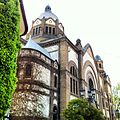
Back Novi Sad Afrikaans نوفي ساد Arabic نوفى ساد ARZ Novi Sad AST Нови-Сад Bashkir Нові-Сад Byelorussian Новы Сад BE-TARASK Нови Сад Bulgarian Novi Sad BJN নোভি সাদ Bengali/Bangla
Novi Sad
| |
|---|---|
| Град Нови Сад Grad Novi Sad City of Novi Sad | |
Panorama of Novi Sad from Petrovaradin fortress Freedom Square | |
|
| |
| Nickname: Serbian Athens | |
| Coordinates: 45°15′15″N 19°50′33″E / 45.25417°N 19.84250°E | |
| Country | |
| Province | |
| District | South Bačka |
| Settled by Scordisci | 4th century B.C. |
| Founded | 1694 |
| City status | 1 February 1748 |
| Government | |
| • Mayor | Žarko Mićin (SNS) |
| • Ruling parties | SNS/SDPS/SPO–SPS/JS–SVM |
| Area | |
| 83 km2 (32 sq mi) | |
| • Urban | 222.66 km2 (85.97 sq mi) |
| • Metro | 699 km2 (270 sq mi) |
| • Rank | 36th in Serbia |
| Elevation | 80 m (262 ft) |
| Population (2022)[2] | |
| 260,438 | |
| • Rank | 2nd in Serbia |
| • Density | 3,100/km2 (8,100/sq mi) |
| • Urban | 325,511 |
| • Urban density | 1,500/km2 (3,800/sq mi) |
| • Metro | 368,967 |
| • Metro density | 530/km2 (1,400/sq mi) |
| Demonym(s) | Novosađanin (Новосађанин, m.) Novosađanka (Новосађанка, f.) (sr) |
| Time zone | UTC+01:00 (CET) |
| • Summer (DST) | UTC+02:00 (CEST) |
| Postal code | 21000 |
| Area code | +381(0)21 |
| Vehicle registration | NS |
| Official languages | Serbian together with Hungarian, Slovak and Pannonian Rusyn[1] |
| Website | www.novisad.rs |
Novi Sad (Serbian: Нови Сад, pronounced [nôʋiː sâːd] ⓘ; see below for other names) is the second largest city in Serbia and the administrative center of the autonomous province of Vojvodina. It is located in the southern portion of the Pannonian Plain on the border of the Bačka and Syrmia geographical regions, lying on the banks of the Danube river, and facing the northern slopes of Fruška Gora. According to the 2022 census[update], the population of Novi Sad city proper stands at 260,438, its contiguous urban area has 325,511 inhabitants, and the population of its administrative area totals 368,967 people.[3] It is the fifth largest city on the Danube river and the largest that is not a national capital.
Novi Sad was founded in 1694, when Serb merchants formed a colony across the Danube from the Petrovaradin Fortress, a strategic Habsburg military post. In subsequent centuries, it became an important trading, manufacturing and cultural centre, and has historically been dubbed the Serbian Athens.[4][5] The city was heavily devastated in the 1848 Revolution, but was subsequently rebuilt and restored. Today, along with the Serbian capital city of Belgrade, Novi Sad is an industrial and financial center important to the Serbian economy.
Novi Sad was the European Youth Capital in 2019 and the European Capital of Culture in 2022.[6] It became a UNESCO Creative City of Media Arts in 2023.[7][8]
- ^ a b c d "Статут Града Новог Сада" [Novi Sad City Statute] (PDF) (in Serbian). City of Novi Sad. Retrieved 10 February 2025.
- ^ Republički zavod za statistiku (Serbia); Kovačević, Miladin, eds. (2023). Nacionalna pripadnost: podaci po opštinama i gradovima (PDF). Popis stanovništva, domaćinstava i stanova 2022. godine. Beograd: Republički zavod za statistiku. ISBN 978-86-6161-228-2.
- ^ "2022 Census of Population, Households and Dwellings: Ethnicity (data by municipalities and cities)" (PDF). Statistical Office of Republic Of Serbia, Belgrade. April 2023. ISBN 978-86-6161-228-2. Retrieved 30 April 2023.
- ^ Mishkova, Diana (1 January 2009). We, the people: politics of national peculiarity in Southeastern Europe. Central European University Press. pp. 277–278. ISBN 9789639776289.
- ^ "History of Novi Sad". Official Website of Novi Sad. Archived from the original on 19 July 2011.
- ^ "Esch, Kaunas and Novi Sad to be European Capitals of Culture in 2022". European Commission.
- ^ "55 new cities join the UNESCO Creative Cities Network on World Cities Day". www.unesco.org. Retrieved 31 October 2023.
- ^ "Novi Sad u Uneskovoj Mreži kreativnih gradova sveta: "Srpska Atina" prva u ovom delu Evrope na Media Arts listi". euronews.rs (in Serbian). 31 October 2023. Retrieved 31 October 2023.














